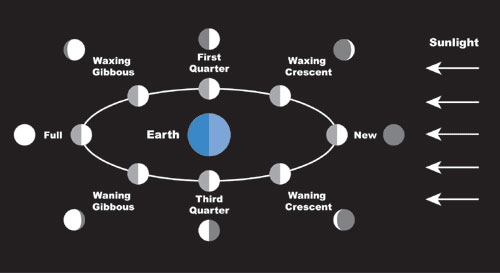We all know that the appearance of the moon changes over time. What causes these changes or the phases of the moon?
Many people mistakenly think the moon gives off its own light. The moon does not give off its own light; instead, it reflects the light given off by the sun.
The moon travels in an elliptical orbit around the Earth at a rate of 2,300 miles per hour. One revolution around the Earth is 1.4 million miles. The gravitational pull keeps the Earth's moon in its orbit. The moon's revolution around Earth is about 29 1/2 days long (from one new moon to the next new moon). The moon rotates or spins on its axis only once during its trip around the Earth. So its revolution and rotation are equal in length.
Because the period of rotation for the moon is the same as its period of revolution, one side of the moon is always sunlit while the other side is always dark. It was not until the Apollo missions that we knew what the far side of the moon looked like.
![]() Watch this simple animation to see how the Earth and moon revolve around the sun.
Watch this simple animation to see how the Earth and moon revolve around the sun.
Source: Sun, Earth, Moon animation, phystv, YouTube
As the moon revolves around the Earth, the angle of the sunlit side of the moon that faces the Earth changes. The different appearances of the moon are called phases.
Click on the link below to access the simulation and study the phases of the moon. Pay close attention to both the position of the moon relative to the Earth and the box in the left hand corner that shows what we see from Earth.
The position of the moon and Earth and the phases as we see them from Earth are shown in the diagram below.

Source: Phases of the moon, Highline Community College
When the moon is waxing, it means that the sunlit part of the moon we can see from Earth is getting larger. When it is waning, the sunlit part of the moon we can see from Earth is getting smaller. Notice that in the picture above that even as the phases of the moon change, the total amount of sunlight the moon gets remains the same. Half the moon is always in sunlight, but the angle of the sunlight on the side of the moon that faces the Earth changes.

Phases of the Moon Match
Directions: Find the name of each phase of the moon and its corresponding picture/definition. Click on the matching boxes.